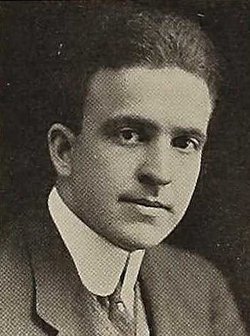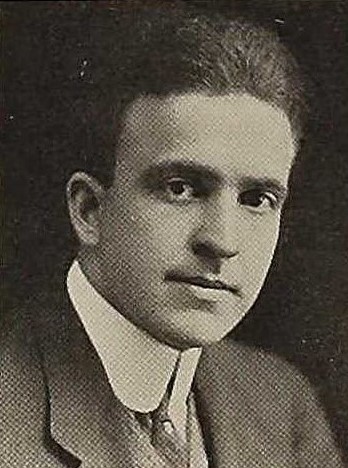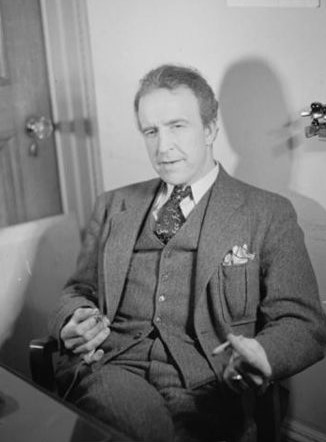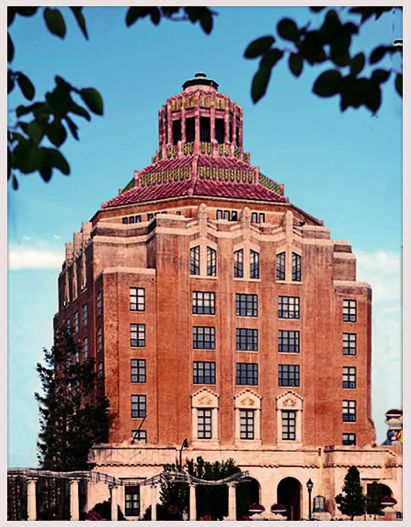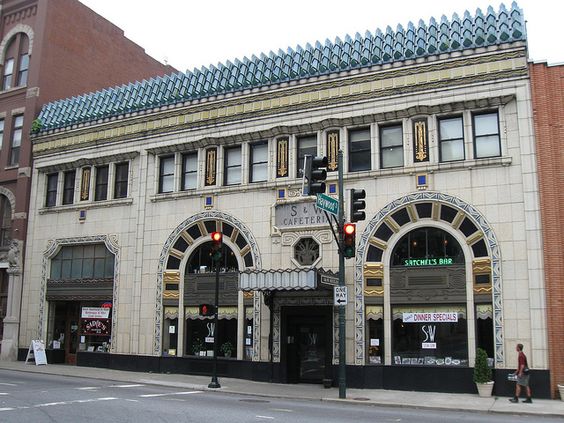Mr. Ellington was graduated from Randolph Macon College in Virginia, and then studied architecture at Drexel Institute and the University of Pennsylvania. In 1911, he won an award to study at the École des Beaux Arts in Paris. In 1913, he won the Prix de Rougevin, a top honor at the school. By 1917, he was a professor of architecture at Carneiee Institute of Technology in Pittsburgh, Pennsylvania.
Mr. Ellington enlisted in the US Navy as a Chief Carpenter's Mate in June of 1918, but in a month, they sent him to the Navy Department in Washington, where he worked on developing camouflage designs, which was a new innovation at the time.
After the War, he opened an architectural office in Pittsburgh with his brother Kenneth R. Ellington. They relocated the office to Asheville, NC in 1926, and Mr. Ellington was responsible for designing a number of amazing buildings in Asheville in the 1920s and later, including the First Baptist Church (1925), the Asheville City Hall (1926), Asheville High School (1927), the Biltmore Hospital and the S & W Cafeteria (both 1929) and many others. I've heard that architects from New York and Miami came here and were inspired by Mr. Ellington's designs to create Art Deco buildings in those cities. Many of Mr. Ellington's designs, some for buildings that were never built, can be found in the Douglas Ellington Collection, at the Asheville Art Museum.
Beginning in 1926, Mr. Ellington and his brother Kenneth began building a country home in Chunn's Cove, using left over materials from their building projects. This is one of the most charming houses I've ever seen, and was later lived in by Kenneth Ellington's daughter, the famed wildlife artist Sallie Ellington Middleton. It was featured in Architectural Digest in 1932, and has been since.
During the early years of the Depression, Mr. Ellington moved to Washington, DC. to serve as principal architect of the federally sponsored town of Greenbelt, Maryland. In 1937, he moved to Charleston, South Carolina to oversee the restoration of this historic Dock Street Theatre.
During the 1940s and 50s, Mr. Ellington designed a number of buildings, churches, homes and government buildings, in Charleston; but he maintained his home at Chunn's Cove as a summer residence, and also designed some further homes in Asheville.
Mr. Ellington was graduated from Randolph Macon College in Virginia, and then studied architecture at Drexel Institute and the University of Pennsylvania. In 1911, he won an award to study at the École des Beaux Arts in Paris. In 1913, he won the Prix de Rougevin, a top honor at the school. By 1917, he was a professor of architecture at Carneiee Institute of Technology in Pittsburgh, Pennsylvania.
Mr. Ellington enlisted in the US Navy as a Chief Carpenter's Mate in June of 1918, but in a month, they sent him to the Navy Department in Washington, where he worked on developing camouflage designs, which was a new innovation at the time.
After the War, he opened an architectural office in Pittsburgh with his brother Kenneth R. Ellington. They relocated the office to Asheville, NC in 1926, and Mr. Ellington was responsible for designing a number of amazing buildings in Asheville in the 1920s and later, including the First Baptist Church (1925), the Asheville City Hall (1926), Asheville High School (1927), the Biltmore Hospital and the S & W Cafeteria (both 1929) and many others. I've heard that architects from New York and Miami came here and were inspired by Mr. Ellington's designs to create Art Deco buildings in those cities. Many of Mr. Ellington's designs, some for buildings that were never built, can be found in the Douglas Ellington Collection, at the Asheville Art Museum.
Beginning in 1926, Mr. Ellington and his brother Kenneth began building a country home in Chunn's Cove, using left over materials from their building projects. This is one of the most charming houses I've ever seen, and was later lived in by Kenneth Ellington's daughter, the famed wildlife artist Sallie Ellington Middleton. It was featured in Architectural Digest in 1932, and has been since.
During the early years of the Depression, Mr. Ellington moved to Washington, DC. to serve as principal architect of the federally sponsored town of Greenbelt, Maryland. In 1937, he moved to Charleston, South Carolina to oversee the restoration of this historic Dock Street Theatre.
During the 1940s and 50s, Mr. Ellington designed a number of buildings, churches, homes and government buildings, in Charleston; but he maintained his home at Chunn's Cove as a summer residence, and also designed some further homes in Asheville.
Gravesite Details
While the death certificate says he was cremated, I believe his ashes were buried at his home at Chunn's Cove.
Family Members
Sponsored by Ancestry
Advertisement
Advertisement
